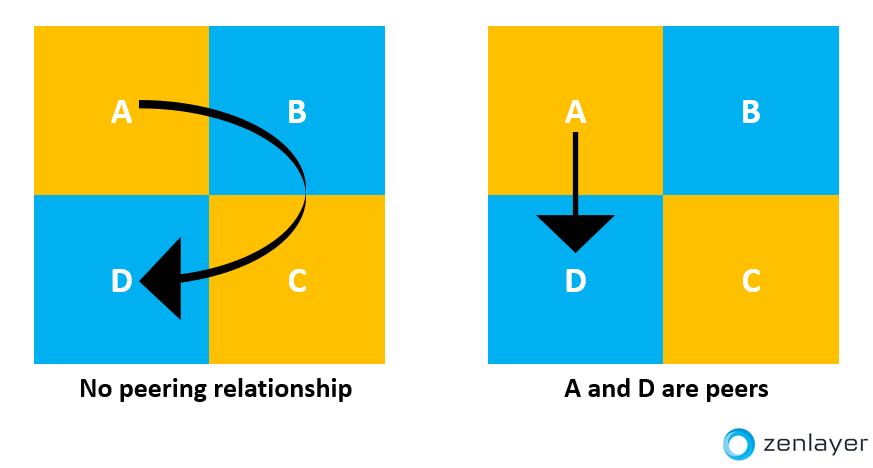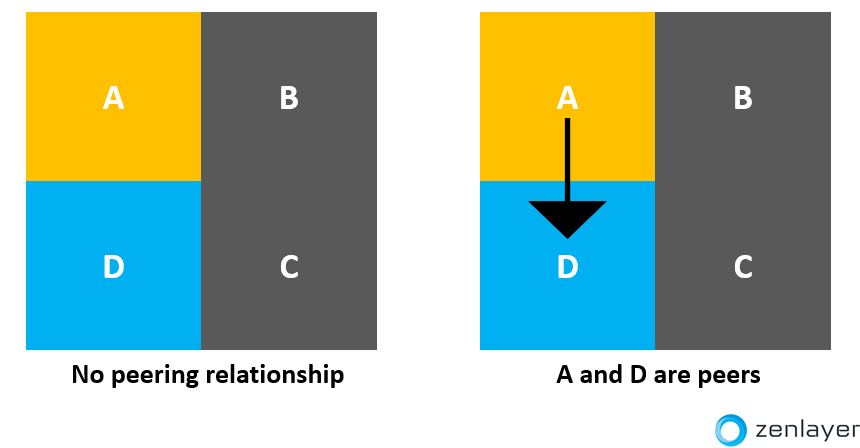Peering is the process by which two networks interconnect to exchange traffic. A peering relationship carries several benefits for its involved networks, such as more efficient routing, reduced transit costs, and improved uptime.
To understand how peering works, you must first understand how the internet is connected.
How is the internet connected?
The internet is a massive network comprised of smaller networks – or groups of connected computers. Each of these connected computers has its own Internet Protocol (IP) address that can be grouped into an IP prefix – or aggregation of IP addresses. A collection of IP prefixes that share a set of clearly defined routing policies is called an autonomous system.
In simpler terms, you can think of an autonomous system as a group of routers managed by a business, a school, a governmental body, or any other single entity.
Each autonomous system is assigned an autonomous system number (ASN) by the Internet Assigned Numbers Authority (IANA) and as of March 2021, 100,000+ unique ASNs have been allocated. In other words, there are now 100,000+ autonomous systems across the world that make up the internet we know today.
The role of BGP
BGP is the protocol that standardizes exchanges of routing information between autonomous systems. In other words, it lets autonomous systems communicate with each other on the internet.
BGP takes the information announced by the autonomous systems and organizes them into a routing table, then makes routing decisions to determine the shortest path based on a multitude of factors. Without BGP, the massively distributed nature of the internet makes routing traffic incredibly complex and inefficient.
Why peering matters
As important as BGP is to the internet, it alone is not enough to smooth out the various bumps of routing traffic on the world wide web.
Traffic over the public internet has to “hop” from network to network on its way to the destination. This means that when you send an instant message to your friend across the world, your message will hop between various networks until it reaches your friend’s inbox. The more networks your data hops through, the higher the latency, and the longer it takes to reach its destination.
When two network entities enter a peering relationship, each agrees to let traffic from the other move through its network freely without a third party. This is important because not only does it speed up traffic, but it also reduces transit costs for all parties involved and improves uptime through network redundancy.
What are the benefits of peering?
1. Peering speeds up traffic

The picture above shows how peering speeds up traffic. On the left, you can see the path that traffic would have to travel when there is no peering relationship between networks A and D. In order for data to move from network A to network D, it must pass through networks B and C. This takes a total of three hops: A to B, B to C, then finally C to D.
On the right, where a peering relationship is established between networks A and D, traffic can pass directly from network A to network D without having to go through other networks – reducing the number of hops to just one. The reverse is also true. Traffic that originates from network D can flow directly into network A instead of having to hop through networks C and B. As you can see, peering is a mutually beneficial relationship that lowers latency and shortens transit time for traffic across both networks.
2. Peering reduces transit costs
Without peering, one network entity has to pay another for bandwidth to carry its traffic towards the destination – an agreement called IP transit. Peering reduces the amount of transit traffic that a provider needs to buy from other networks, which lowers the cost of data transmission. The more peers that a network entity has, the less it has to pay to move traffic across the internet. Indeed, peering is what makes the internet affordable and accessible in many places around the world. If the internet relied on paid IP transit for all traffic, the cost would be outrageous and very few of us would be able to afford to go online at all.
3. Peering improves uptime

The figures shown above represent a scenario in which networks B and C are down. On the left, where there is no peering relationship between networks A and D, traffic from network A would have no way of reaching network D. On the right, peering between networks A and D opens up a redundant path (to the now unavailable A > B > C > D path) that lets traffic flow from A directly to D. Similarly, it opens up a redundant path from network D to A instead of the scenic but now disconnected route of D > C > B > A.
As you can imagine, a network that has many peers offers many alternative paths for traffic even if intermediary networks aren’t accessible. This improves the network’s uptime and the reliability of its services.
Speed up your network with Zenlayer and peers!
Zenlayer has 10,000+ peers around the world that can help boost your network’s performance, latency, and data ingestion, and we’re constantly adding new peers.
If you want to take advantage of our high-speed global network to help streamline business operations and improve user experience, check out our customer success story and talk to a solution expert today!







